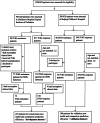Predictive model based on gene and laboratory data for intravenous immunoglobulin resistance in Kawasaki disease in a Chinese population
- PMID: 34174887
- PMCID: PMC8236184
- DOI: 10.1186/s12969-021-00582-6
Predictive model based on gene and laboratory data for intravenous immunoglobulin resistance in Kawasaki disease in a Chinese population
Abstract
Background: Here, we investigated the predictive efficiency of a newly developed model based on single nucleotide polymorphisms (SNPs) and laboratory data for intravenous immunoglobulin (IVIG) resistance in Kawasaki disease (KD) in a Chinese population.
Methods: Data relating to children with KD were acquired from a single center between December 2015 and August 2019 and used to screen target SNPs. We then developed a predictive model of IVIG resistance using previous laboratory parameters. We then validated our model using data acquired from children with KD attending a second center between January and December 2019.
Results: Analysis showed that rs10056474 GG, rs746994GG, rs76863441GT, rs16944 (CT/TT), and rs1143627 (CT/CC), increased the risk of IVIG-resistance in KD patients (odds ratio, OR > 1). The new predictive model, which combined SNP data with a previous model derived from laboratory data, significantly increased the area under the receiver-operator-characteristic curves (AUC) (0.832, 95% CI: 0.776-0.878 vs 0.793, 95%CI:0.734-0.844, P < 0.05) in the development dataset, and (0.820, 95% CI: 0.730-0.889 vs 0.749, 95% CI: 0.652-0.830, P < 0.05) in the validation dataset. The sensitivity and specificity of the new assay were 65.33% (95% CI: 53.5-76.0%) and 86.67% (95% CI: 80.2-91.7%) in the development dataset and 77.14% (95% CI: 59.9-89.6%) and 86.15% (95% CI: 75.3-93.5%) in the validation dataset.
Conclusion: Analysis showed that rs10056474 and rs746994 in the SMAD5 gene, rs76863441 in the PLA2G7 gene, and rs16944 or rs1143627 in the interleukin (IL)-1B gene, were associated with IVIG resistant KD in a Chinese population. The new model combined SNPs with laboratory data and improved the predictve efficiency of IVIG-resistant KD.
Keywords: Intravenous immunoglobulin resistance; Kawasaki disease; Single nucleotide polymorphism.
Conflict of interest statement
The authors declare that they have no competing interests.
Figures




Similar articles
-
The IL-1B Gene Polymorphisms rs16944 and rs1143627 Contribute to an Increased Risk of Coronary Artery Lesions in Southern Chinese Children with Kawasaki Disease.J Immunol Res. 2019 Apr 9;2019:4730507. doi: 10.1155/2019/4730507. eCollection 2019. J Immunol Res. 2019. PMID: 31093510 Free PMC article.
-
Association between P2RY12 Gene Polymorphisms and IVIG Resistance in Kawasaki Patients.Cardiovasc Ther. 2020 Mar 10;2020:3568608. doi: 10.1155/2020/3568608. eCollection 2020. Cardiovasc Ther. 2020. PMID: 32256707 Free PMC article.
-
The clinical value of dynamic monitoring of complete blood count in predicting immunoglobulin resistance in Chinese children with Kawasaki disease.Sci Rep. 2025 May 23;15(1):18041. doi: 10.1038/s41598-025-03337-5. Sci Rep. 2025. PMID: 40410427 Free PMC article.
-
Higher efficacy of infliximab than immunoglobulin on Kawasaki disease, a meta-analysis.Eur J Pharmacol. 2021 May 15;899:173985. doi: 10.1016/j.ejphar.2021.173985. Epub 2021 Feb 27. Eur J Pharmacol. 2021. PMID: 33652059
-
Current pharmacological intervention and development of targeting IVIG resistance in Kawasaki disease.Curr Opin Pharmacol. 2020 Oct;54:72-81. doi: 10.1016/j.coph.2020.08.008. Epub 2020 Sep 18. Curr Opin Pharmacol. 2020. PMID: 32956895 Free PMC article. Review.
Cited by
-
Single Nucleotide Polymorphisms and Their Association with Coronary Artery Aneurysms and IVIG Resistance in Kawasaki Disease in Ireland.Pediatr Cardiol. 2025 Aug 8. doi: 10.1007/s00246-025-03989-0. Online ahead of print. Pediatr Cardiol. 2025. PMID: 40775473
-
Diagnostic model based on bioinformatics and machine learning to distinguish Kawasaki disease using multiple datasets.BMC Pediatr. 2022 Aug 30;22(1):512. doi: 10.1186/s12887-022-03557-y. BMC Pediatr. 2022. PMID: 36042431 Free PMC article.
-
Candidate SNP Markers Significantly Altering the Affinity of the TATA-Binding Protein for the Promoters of Human Genes Associated with Primary Open-Angle Glaucoma.Int J Mol Sci. 2024 Nov 28;25(23):12802. doi: 10.3390/ijms252312802. Int J Mol Sci. 2024. PMID: 39684516 Free PMC article.
-
Efficacy of Gamma Globulins in Children with Kawasaki Disease and Factors Influencing Children's Short-Term Prognosis.Comput Math Methods Med. 2022 Jul 30;2022:5137874. doi: 10.1155/2022/5137874. eCollection 2022. Comput Math Methods Med. 2022. PMID: 35941893 Free PMC article.
References
-
- Bar-Meir M, et al. Prediction of resistance to intravenous immunoglobulin in children with Kawasaki disease. J Pediatric Infect Dis Soc. 2018;7(1):25–29. - PubMed
MeSH terms
Substances
Grants and funding
LinkOut - more resources
Full Text Sources
Medical
Miscellaneous

